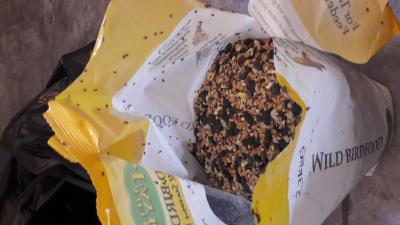Recently, one of our technicians, Martin Colyer, came across an unusual problem at a flat in Cricklewood. He had been called to the flat to deal with an infestation of carpet beetles but when he arrived, he found something very different – weevils.
To be more precise – wheat or grain weevils. Now, as you might guess from the name, these pests don’t eat carpets and so Martin had to turn sleuth to find the source of the problem. In the end, he followed the trail back to a packet of unused birdseed. The owners had brought the seed in the winter to feed the birds and then had some left over. In the intervening period, the weevils had decided to take advantage and, as you can see from the video, the packet was now fully infested.
In this day and age, it isn’t common to see these nasty little pests in the UK but in the past, they were very common. Talking about this to a friend who studied Roman archaeology, he recalled how it was not unknown to find burnt layers inside Roman military camps. The original interpretation depended on the sensationalism of the excavator; they were either accidental or the remnants of an attack by a local tribe. In fact, there is now a far more probable cause for the destruction layer – the Romans burning down the granaries when they become too infested with grain weevils.
Looking at a study by the University of Birmingham, it seems like we have the Romans to thank for the introduction of the grain weevil into the UK as before they arrived we don’t seem to have had any. It is surmised that this is because grain was stored in underground pits before the arrival of the Romans and this made it difficult for the weevils.
So, what are these little pests?
An adult weevil is around two to three millimetres in length, is dark brown in appearance, and has a long snout-like projection at the front. This last defining feature is very common among weevils and there are certainly a lot of different types of weevil – over 60,000 different species. Most of them are unable to fly but there are exceptions. One such exception if the rice weevil, which looks very similar to the grain weevil, except grain weevils are wingless.
Particularly disconcerting, and this may explain the Roman military’s drastic approach to pest control, is that a pair of wheat weevils can lay 250 eggs at a time and can multiply their population fifteen times in a month! The female will bore a microscopic hole into a food grain with her mouthparts and then lay a single egg inside. She will then seal the hole with a gelatinous secretion. They prefer grain with a good moisture content and the optimum temperature for development is 26-30C. The larvae will develop inside the grain and then bore their way out when they are fully developed. An adult can then live for up to eight months once it has emerged. In general, adults will eschew light in favour of darkness and are known to feign death if they are handled.
If you find you have an infestation, you don’t necessarily need to take the same drastic steps as a Roman. It should be enough to dispose of the infested produce and clean up any spillages. Of course, as we promote for nearly every pest, prevention is far better than cure. Key to this is sanitation and inspection. Grains, and it isn’t just wheat and barley, should always be stored in tightly-sealed containers, preferably made of metal. You’d be amazed how effective the mouth of a weevil can be on a cardboard box. If possible, containers should also be stored in a fridge or freezer.
If you suspect an infestation, one trick to finding out if you grain is infested is to submerge the suspected grain in water. If the grain has been used to nurture larvae, it will float. The infested grain should then be disposed of immediately and the area treated to stop a recurring problem.
As you can see from Martin’s pictures and video, this is an unpleasant problem and it will certainly put you off your food to see them darting around your stored grains. It’s not a common problem for Cleankill but it certainly isn’t unknown, and we have had to deal with a few large-scale infestations over the years. To learn more dealing with wheat weevils, read our ‘Food Pest’ page on Cleankill.co.uk.
